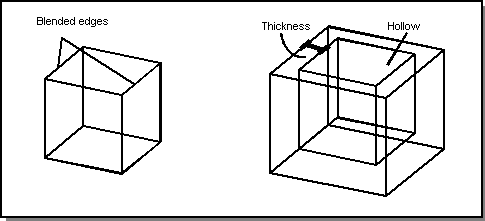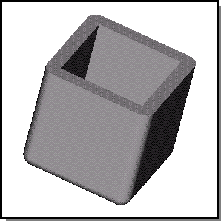Shelling
The Shelling Component (SHL), creates thin-walled solids by offsetting all faces of a solid model by a specified distance. This creates a shelled model of the type used extensively in manufacturing injection molded parts. SHL requires the Local Operations Component (LOP).
SHL handles a wide variety of topology changes. Topology changes primarily occur when a solid has fillets that have a radius smaller that the offset distance of the shell.
SHL allows blend removal. When a hollow body is created, faces whose geometry would degenerate as a result of the offset are removed prior to the offset. If a body with blended edges or vertices is hollowed inwards by more than the blend radius, the blends will be removed.
When shelled, a solid model changes drastically by becoming a thin-walled solid with inner or outer faces generally coincident with the original body faces. The shelling operation can be regarded as a local operation because faces are expected only to interact with their immediate neighbors, thus explaining the thinness restriction on the walls.
Shelling forms an essential link between surface modeling and solid modeling. A typical application of shelling is found in sheet-metal and plastic industries where thin-walled solids need to be modeled from solids.
Topics include:
Types of Shelling
Shelling is performed by copying and offsetting the faces of the body, thus creating a void. Faces may be omitted from the process, which results in an opening being generated into the void, leaving a body with inner and outer faces, with one part generally coincident with the original body. A shell can be created in two ways:
- Hollow
- creates a thin-walled solid shell from a solid body.
- Thicken-sheet
- thickens a sheet to a solid body.
SHL provides APIs for integration with modeling software using ACIS.
Shelling and Blends
If shelling is applied to bodies that are blended, the blended faces can be treated as blends or as regular faces.
If the blended faces are treated as blends, the properties of the blend are preserved. The shelling operation recalculates the blend geometry so that it remains tangent to its supporting surfaces. As with most local operations, the topology of the blend cannot change.
If the blended faces are treated as regular faces, then the edge between the blend and its supporting face is recalculated by intersecting the corresponding surfaces. An intersection must exist for the operation to work. The new edge is unlikely to be a tangent one; in general it will bite into the blend surface.
The recommended technique is to treat the blend as a blend because this does not depend on the existence of intersections to work.

Figure. Shelling Original and Result
The following figure illustrates a thin-walled solid created by shelling with a topology change to collapse the blends. The original block had blended edges. When shelled to the inside, the blends on the inside shell were removed.

Figure. Blends Removed by Shelling
Faces supplied to shelling are excluded from the list of faces processed, and only those not explicitly supplied can be treated as blends.
In order for a face to be treated as a blend it must have a blend attribute attached. Blending attaches suitable attributes to faces if the option add_bl_atts is switched on. Alternatively, the user may add the attributes to existing surfaces (made by blending or otherwise) using the appropriate API call.
Limitations
SHL has the following limitations:
- The sheet supplied to the thicken-sheet must be manifold, single lump, and single shell.
- No topology changes are allowed except for:
- The removal of radial faces that cannot be offset and fixing the gap
- The generation of offset inner or outer faces and any openings between them
- Topology changes allowed by tweak_faces
- Shelling operations may fail on non-G1 surfaces
- Shelling must fall within the radius of the curvature (is not capable of self-intersecting).
- SHL relies on standard blending (using the Blending Component) It cannot produce blends that are outside the scope of standard blending. In addition, blending performed by SHL does not presently work on variable radius blends, blends on blends, vertex blends, or entity-entity blends supported by the Advanced Blending Component. All blends in a sequence need to be treated consistently.
- Individual APIs may also have specific limitations.
[Top]
© 1989-2007 Spatial Corp., a Dassault Systèmes company. All rights reserved.